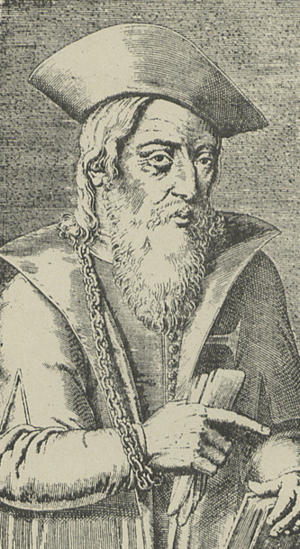Francisco de Sá de Miranda facts for kids
Quick facts for kids
Francisco de Sá de Miranda
|
|
|---|---|
 |
|
| Born | 28 August 1481 |
| Died | 17 May 1558 (aged 76) Amares, Kingdom of Portugal
|
| Nationality | Portuguese |
| Occupation | Poet |
Francisco de Sá de Miranda was an important Portuguese poet. He lived during the Renaissance, a time of great change in art and learning. He was born on August 28, 1481, and passed away on May 17, 1558. Sá de Miranda is famous for bringing new styles of poetry to Portugal.
Contents
Francisco de Sá de Miranda: A Renaissance Poet
Early Life and Education
Sá de Miranda was born in Coimbra, Portugal. His father, Gonçalo Mendes de Sá, was a church official. His family was old and well-known. Sá de Miranda's brother, Mem de Sá, later became the third governor of the Portuguese colony in Brazil.
He spent his early years near the Mondego River, which inspired many poets. He studied Greek, Latin, and philosophy at the Santa Cruz Monastery. In 1505, he went to the University of Coimbra (which was in Lisbon at the time) to study law.
While studying, he also spent time at the Portuguese royal court. He started writing poems in the older, medieval style. He became part of a group of famous poets and nobles. These included Bernardim Ribeiro and Cristóvão Falcão.
By 1516, he had earned a degree in law. He was even offered a job as a judge, but he turned it down. Sá de Miranda only studied law to please his father. After his father died, he chose to focus on philosophy and poetry instead.
Travels and New Ideas
In 1521, Sá de Miranda traveled to Italy. This was a very important trip for him. In Italy, he met many famous writers and artists of the Renaissance. Some of these included Vittoria Colonna, Pietro Bembo, and Ariosto.
He saw new types of plays being performed in Italy. These plays were based on ancient Roman and Greek styles. Sá de Miranda decided he wanted to bring these new ideas back to Portugal. On his way home in 1526, he visited Spain. There, he met Spanish writers like Juan Boscan and Garcilaso de la Vega.
Return to Portugal and Later Years
Sá de Miranda returned to Portugal in 1526 or 1527. He was welcomed back at the royal court. He became friends with King John III and other important people. His fame as a poet grew, but he also faced opposition from other writers.
He felt sad about how much people cared about money and how little they cared about farming. Around 1530, he married Briolanja de Azevedo, a noblewoman. Four years after returning, he decided to leave the court. He moved to the Minho province in northern Portugal and bought land.
In 1552, he moved to a place called Quinta da Tapada, near Amares. He kept writing and received works from other poets. This showed how much influence he had. Sadly, he faced several losses in his later years. His oldest son died in 1553, and his wife died in 1555. His friend King John III passed away in 1557. Sá de Miranda died the next year, in 1558, at the age of 76.
Sá de Miranda's Literary Works
Introducing New Poetic Forms
Like many Portuguese writers of his time, Sá de Miranda often wrote in Spanish as well as Portuguese. His early poems were in the traditional Portuguese styles. These included forms like the vilancete and the cantiga.
His travels in Italy and Spain changed his writing. He brought new styles of poetry to Portugal. He introduced the sonnet, the elegy, the eclogue, and the ottava rima. He also adapted the Portuguese language to fit the Italian hendecasyllable verse. This is a line of poetry with eleven syllables.
These new forms, especially the sonnet and ottava rima, became very popular. Many Portuguese poets used them later, including the famous Luís Vaz de Camões.
Plays and Letters
Besides poems, Sá de Miranda also wrote two comedies for the theater. These plays followed classical styles. Estrangeiros was the first Portuguese prose comedy. It was very successful when performed in Coimbra in 1528. His other comedy, Vilhalpandos, was written around 1530.
He also wrote several letters in verse. These letters were addressed to people like King John III and his brother Mem de Sá.
See also
 In Spanish: Francisco Sá de Miranda para niños
In Spanish: Francisco Sá de Miranda para niños

